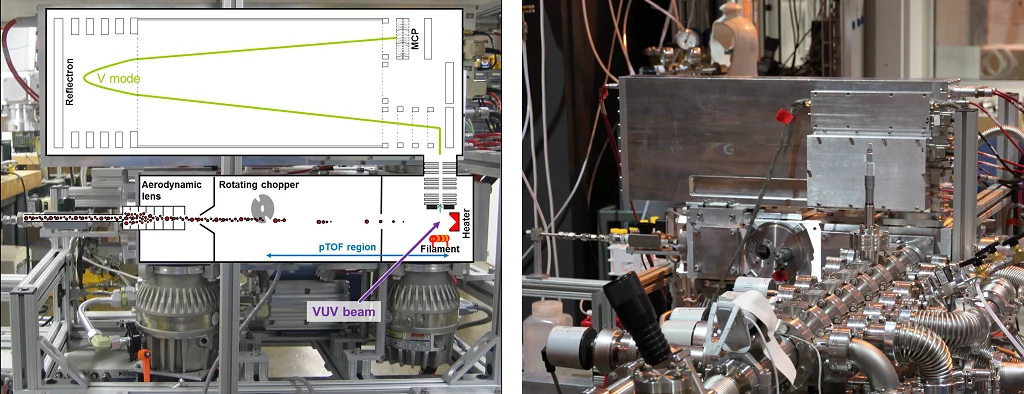Scope of project
The effects of atmospheric aerosols on the earth’s climate, visibility and human health are highly recognized but poorly constrained. Where the inorganic fraction of the ambient aerosol is generally well characterized, the organic fraction is poorly understood. This is due to the complex chemistry and composition of the organic fraction and the difficulty in simultaneously detecting a wide range of compounds with both high time resolution and chemical specificity.
In the last decade, online aerosol mass spectrometry utilizing electron ionization (EI) has become a proven technique for highly time-resolved analysis of the organic aerosol concentration and composition. However, due to the extensive fragmentation of the molecular ions, speciation of compounds and identification of emission sources (particularly in the SOA fraction) has been difficult. Photoionization, in contrast to EI, is a relatively soft ionization technique which leads to less fragmentation and more high-mass fragments. The complementary information that supports the identification of the different aerosol sources is highly desirable and could be used as basis for possible future legislations.
The project combines the expertise of the Laboratory of Atmospheric Chemistry (LAC) with that of the Laboratory for Catalysis and Sustainable Chemistry (LSK) to exploit VUV photoionization for improved chemical speciation in the Aerodyne aerosol mass spectrometer (AMS). Additionally, unimolecular reaction studies of atmospherically relevant compounds will be conducted using imaging photoelectron photoion coincidence (iPEPICO) experiments.
The first part of the project aims to couple the AMS with the X04DB synchrotron VUV beamline at the Swiss Light Source (SLS) to investigate model compounds of ambient aerosol sources, samples of ambient aerosols and secondary aerosols produced in a reaction chamber. This project will be the first study to focus on a structural investigation of aerosol components and real aerosol samples by VUV ionization.
The second part of the projects includes fundamental mapping of molecular ion fragmentation energetics for environmentally relevant molecules. An aerosol delivery system will be coupled to the iPEPICO apparatus which uses the combination of a slow electron velocity map imaging spectrometer with a time-of-flight mass spectrometer.
The instrumental developments will lead to advances of the fundamental knowledge of the analysis of aerosols and aerosol compounds with different ionization techniques. The results of these measurements will provide clear benefits towards resolving hard-to-distinguish atmospheric aerosol sources and will enhance the interpretation of existing and future aerosol mass spectrometric measurements. Overall, this project will improve our understanding of the aerosol composition and its sources which are the foundation for future legislation to reduce the adverse effects of ambient aerosol.
In the last decade, online aerosol mass spectrometry utilizing electron ionization (EI) has become a proven technique for highly time-resolved analysis of the organic aerosol concentration and composition. However, due to the extensive fragmentation of the molecular ions, speciation of compounds and identification of emission sources (particularly in the SOA fraction) has been difficult. Photoionization, in contrast to EI, is a relatively soft ionization technique which leads to less fragmentation and more high-mass fragments. The complementary information that supports the identification of the different aerosol sources is highly desirable and could be used as basis for possible future legislations.
The project combines the expertise of the Laboratory of Atmospheric Chemistry (LAC) with that of the Laboratory for Catalysis and Sustainable Chemistry (LSK) to exploit VUV photoionization for improved chemical speciation in the Aerodyne aerosol mass spectrometer (AMS). Additionally, unimolecular reaction studies of atmospherically relevant compounds will be conducted using imaging photoelectron photoion coincidence (iPEPICO) experiments.
The first part of the project aims to couple the AMS with the X04DB synchrotron VUV beamline at the Swiss Light Source (SLS) to investigate model compounds of ambient aerosol sources, samples of ambient aerosols and secondary aerosols produced in a reaction chamber. This project will be the first study to focus on a structural investigation of aerosol components and real aerosol samples by VUV ionization.
The second part of the projects includes fundamental mapping of molecular ion fragmentation energetics for environmentally relevant molecules. An aerosol delivery system will be coupled to the iPEPICO apparatus which uses the combination of a slow electron velocity map imaging spectrometer with a time-of-flight mass spectrometer.
The instrumental developments will lead to advances of the fundamental knowledge of the analysis of aerosols and aerosol compounds with different ionization techniques. The results of these measurements will provide clear benefits towards resolving hard-to-distinguish atmospheric aerosol sources and will enhance the interpretation of existing and future aerosol mass spectrometric measurements. Overall, this project will improve our understanding of the aerosol composition and its sources which are the foundation for future legislation to reduce the adverse effects of ambient aerosol.
Key findings
- The first measurements with the AMS-VUV setup at the SLS were successfully performed on the 29th of May 2014. Several compounds were analyzed using the AMS with EI and VUV ionization at different conditions. Data analysis is in progress and future measurements are planned.
Funding
The project is funded by the PSI CROSS initiative as collaborative effort between the Laboratory of Atmospheric Chemistry (LAC) in ENE and the Laboratory for Catalysis and Sustainable Chemistry (SYN) in LSK.
This research received funding from the European Community's Seventh Framework Program (FP7/2007-2013) under grant agreement n.°290605 (COFUND: PSI-FELLOW).
Publications
Journal Articles
Dissociative Ionization Mechanism and Appearance Energies in Adipic Acid Revealed by Imaging Photoelectron Photoion Coincidence, Selective Deuteration, and CalculationsHeringa, M. F., Slowik, J. G., Prevot, A. S., Baltensperger, U., Hemberger, P., and Bodi, A., 2016.
J Phys Chem A, 120, 3397-3405, 10.1021/acs.jpca.6b00908.
Conference Contributions
Vacuum ultraviolet photoionization of atmospherically relevant aerosol components using an Aerodyne aerosol mass spectrometer.M.F. Heringa, J.G. Slowik, A.S.H, Prévôt, U. Baltensperger, P. Hemberger and A. Bodi.
EAC 2015, Milan, Italy.
Comparison of electron ionization and vacuum ultraviolet photoionization of atmospherically relevant aerosol components using an aerosol mass spectrometer.
M.F. Heringa, J.G. Slowik, A.S.H, Prévôt, U. Baltensperger, P. Hemberger and A. Bodi.
IMSC 2014, Geneva, Switzerland.


